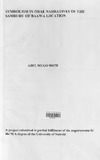| dc.description.abstract | An analysis of the oral narratives of the Samburu of Baawa location exposes a rich employment of symbols. These symbols are either generated within the performance or imported from the community's culture. Symbolism enhances the aesthetic and cognitive qualities of an oral narrative as this study affirms.
The study revisits the debate on methodology in oral literature. It looks at the terms, research techniques, methods and methodology. A researcher should provide a justification for the choice, development and employment of the instruments in the research. The study further gives an in depth narration of the methodology employed in the research.
The study avails itself of deconstruction. At the core of the theory is the difference in meaning as determined by context, and the existence of binary oppositions in a text. Cohesion in a text is dismantled by the internal logic of the text. The very elements that construct a text contribute to its deconstruction.
This study inquires into the influences of space, audience and the narrator. The performance space becomes the space upon which the psyche and the community engage in negation and negotiation to create a consciousness. As the study reveals, symbols are read at different structural levels and at each level a symbol makes a different representation. This deference is the source of aporia and cohesion in the text. | en |

